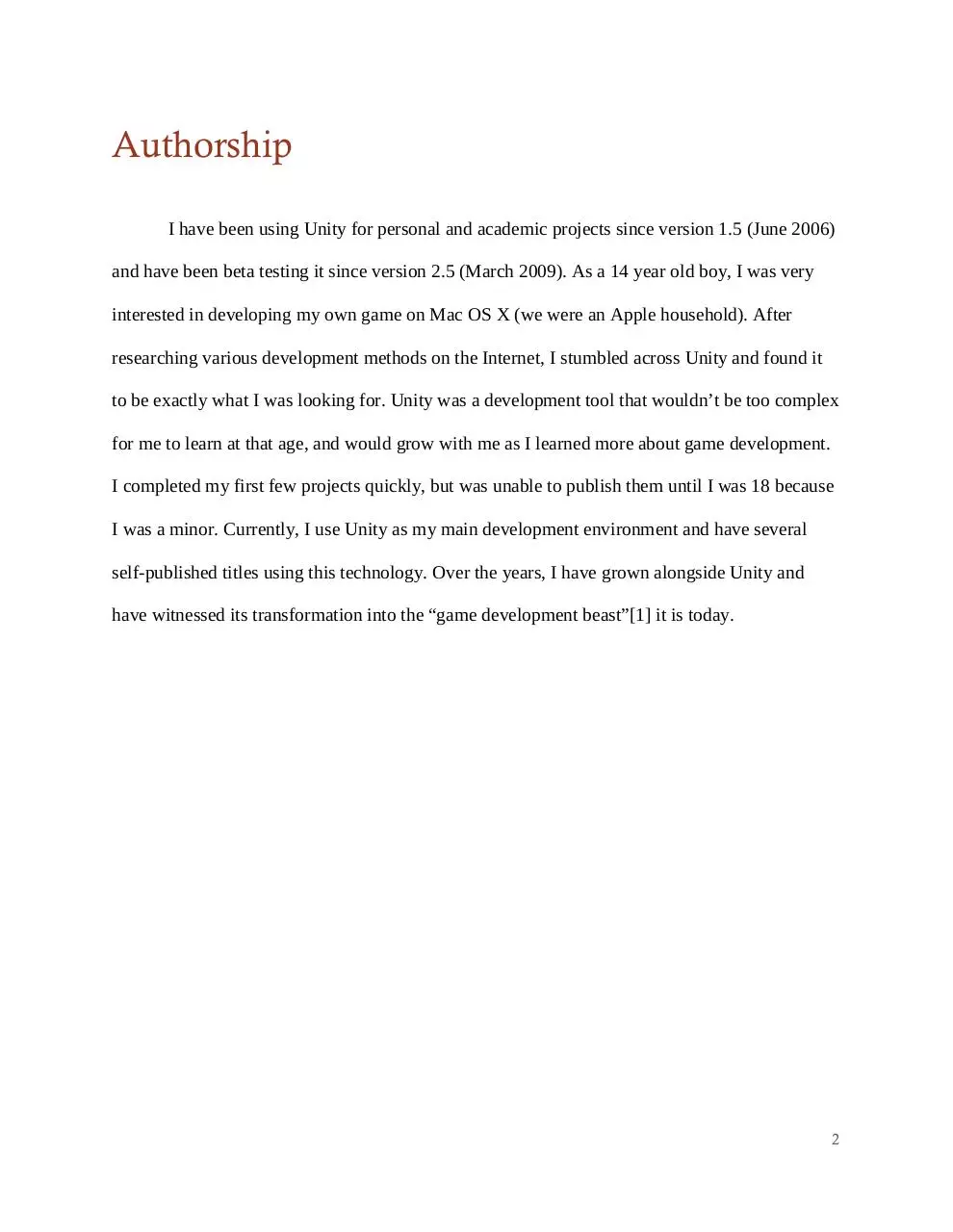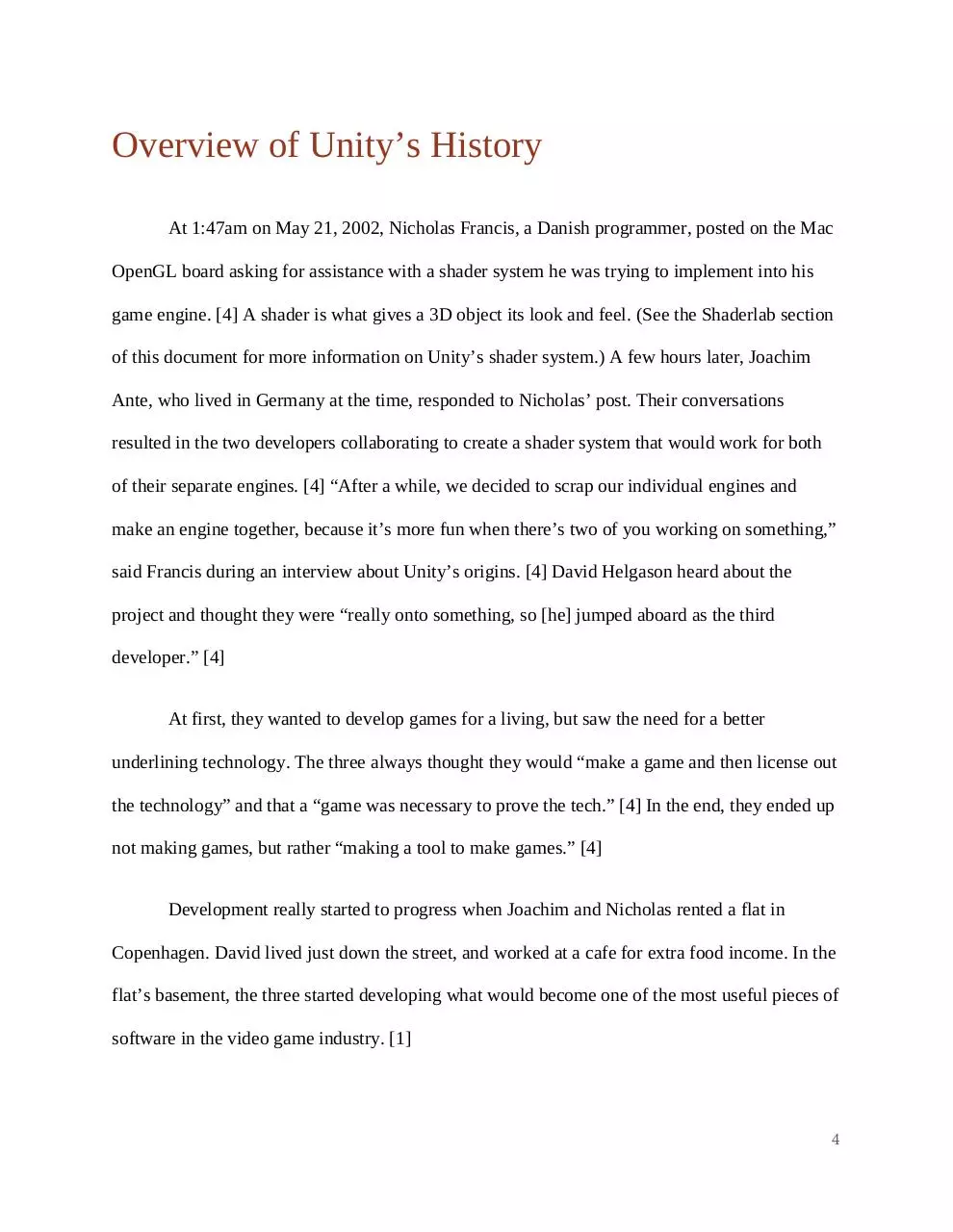Haas IQP Final (PDF)
File information
Title: Abstract
Author: Jake
This PDF 1.5 document has been generated by Acrobat PDFMaker 11 for Word / Adobe PDF Library 11.0, and has been sent on pdf-archive.com on 30/10/2016 at 17:48, from IP address 64.180.x.x.
The current document download page has been viewed 830 times.
File size: 1.29 MB (44 pages).
Privacy: public file





File preview
A History of the Unity Game Engine
An Interactive Qualifying Project
Submitted to the Faculty of WORCESTER POLYTECHNIC INSTITUTE
in partial fulfillment of the requirements for graduation
John Haas
Project Advisor:
Brian Moriarty, IMGD
Abstract
Unity (commonly known as Unity3D) is a game engine and integrated development
environment (IDE) for creating interactive media, typically video games. As CEO David
Helgason put it, Unity “is a toolset used to build games, and it’s the technology that executes the
graphics, the audio, the physics, the interactions, [and] the networking.” [1] Unity is famous for
its fast prototyping capabilities and large number of publishing targets.
The first version of Unity (1.0.0) was created by colleagues: David Helgason, Joachim
Ante and Nicholas Francis in Denmark. [1] The initial product launched on June 6, 2005. [2] The
goal was to create an affordable game engine with professional tools for amateur game
developers while “democratize[ing the] game development” industry.[3] The three were inspired
by the easy workflow, simple asset pipeline, and drag-and-drop interface of Apple’s Final Cut
Pro product.[1] When originally released, Unity was available solely for Mac OS X, and
developers could only deploy their creations to a few platforms. The current version (4.3.1 as of
this writing) is supported on both Windows and Mac OS X, and offers at least a dozen target
platforms. Publishing 64-bit executables has been possible in Unity for a long time, but a 64-bit
version of the Editor is not yet available, though highly anticipated from the development
community.
Abstract
1
Authorship
I have been using Unity for personal and academic projects since version 1.5 (June 2006)
and have been beta testing it since version 2.5 (March 2009). As a 14 year old boy, I was very
interested in developing my own game on Mac OS X (we were an Apple household). After
researching various development methods on the Internet, I stumbled across Unity and found it
to be exactly what I was looking for. Unity was a development tool that wouldn’t be too complex
for me to learn at that age, and would grow with me as I learned more about game development.
I completed my first few projects quickly, but was unable to publish them until I was 18 because
I was a minor. Currently, I use Unity as my main development environment and have several
self-published titles using this technology. Over the years, I have grown alongside Unity and
have witnessed its transformation into the “game development beast”[1] it is today.
2
Table of Contents
Abstract ............................................................................................................................ 1
Authorship ....................................................................................................................... 2
Overview of Unity’s History ............................................................................................... 4
The Unity Editor .............................................................................................................. 12
The Mac Factor ............................................................................................................... 15
Asset Pipeline and Workflow ............................................................................................ 16
Non-Game Uses .............................................................................................................. 17
Multiplatform .................................................................................................................. 18
Globalization and Expansion............................................................................................. 18
Scripting Languages ......................................................................................................... 19
Union / Unity Games ....................................................................................................... 22
Publications / Tutorials About Unity .................................................................................. 23
Unity Cloud .................................................................................................................... 23
Licensing Unity ............................................................................................................... 24
Unite .............................................................................................................................. 25
Asset Store ...................................................................................................................... 26
Appendix I: Notable Publications ................................................................................... 28
Appendix II: Awards and Accolades .................................................................................. 32
Appendix III: Supported File Types ................................................................................... 34
Appendix IV: Scripting Language Comparison ................................................................... 35
Appendix V: Unity Publication List ................................................................................ 36
3
Overview of Unity’s History
At 1:47am on May 21, 2002, Nicholas Francis, a Danish programmer, posted on the Mac
OpenGL board asking for assistance with a shader system he was trying to implement into his
game engine. [4] A shader is what gives a 3D object its look and feel. (See the Shaderlab section
of this document for more information on Unity’s shader system.) A few hours later, Joachim
Ante, who lived in Germany at the time, responded to Nicholas’ post. Their conversations
resulted in the two developers collaborating to create a shader system that would work for both
of their separate engines. [4] “After a while, we decided to scrap our individual engines and
make an engine together, because it’s more fun when there’s two of you working on something,”
said Francis during an interview about Unity’s origins. [4] David Helgason heard about the
project and thought they were “really onto something, so [he] jumped aboard as the third
developer.” [4]
At first, they wanted to develop games for a living, but saw the need for a better
underlining technology. The three always thought they would “make a game and then license out
the technology” and that a “game was necessary to prove the tech.” [4] In the end, they ended up
not making games, but rather “making a tool to make games.” [4]
Development really started to progress when Joachim and Nicholas rented a flat in
Copenhagen. David lived just down the street, and worked at a cafe for extra food income. In the
flat’s basement, the three started developing what would become one of the most useful pieces of
software in the video game industry. [1]
4
One of the major reasons for Unity’s success was its support for independent developers
who did not have the resources to license expensive game development technology. They knew
they wanted to build some sort of game technology, but did not know which medium to use. Two
years later, the trio found their mission: to create the definitive tool for 3D on the web. With this
driving factor, the group took out substantial loans to open an office and hire a few engineers.
The group was looking for a CEO, and initially thought that they would take turns fulfilling this
position. They quickly realized that this would not work if they wanted to become successful.
They put out an ad saying “Have great tech, need CEO.” [4] They got a few applicants, but
everyone they found was “slightly behind the curve - even though we weren’t that far ahead,”
explains Helgason. [4] Helgason was the more social of the three, so the CEO position fell to
him.
At this point, the group incorporated under the name Over the Edge Entertainment
(OTEE) and started to form a business plan. They modeled their company after the British game
development company Criterion, who was becoming very successful with the PlayStation 2
middleware market. [4] Criterion’s model was not just to have good underlying technology, but
also have multiple large titles using the technology. The thought was that consumers would not
feel comfortable enough to license an expensive engine without seeing major game developers
using it first.
5
Screenshots of early Unity version. Pre-initial release. ~Version 0.2b [41]
6
OTEE realized that casual and online gaming was only going to grow, and decided to
focus their efforts on this market. After two years of coding, and many sleepless nights, Unity
was nearing launch and the team decided they needed to make a full commercial game using
their new engine. They did this not only to test the strengths and limits of their engine, but also to
earn enough revenue for food and future development. [5] “Nobody really remembers how we
survived in that period except we probably didn’t eat much,” said David Helgason. [1]
OTEE spent five months creating a game called Gooball using the new engine, which
was still in beta. Gooball was published in March 2005 by Ambrosia Software. [6] The Unity
team used this opportunity to tear apart their engine to find bugs, remove annoyances, and fix the
interface before its official release. [5]
In-game screenshot of Gooball, [30]
7
Using the profits from Gooball, OTEE hired more developers to refine Unity before its
initial 1.0 release in June 2005. They wanted to give Unity the best possible chance to succeed,
so they smoothed out all the rough edges and also provided extensive documentation and support
for the users. After its release, the company immediately began work on the next iteration of
Unity.
“We were developers developing for other developers, we understood their problems and
tried to fix them; we spoke to them. It’d be a case of not being able to sleep at night and
thinking, ‘I wonder what’s going on the forums.’ It was all hours of the day. I think they
recognized that, and then those customers we had started evangelizing it for us.” [1]
At this point, Unity was a baby to the video game industry. The majority of users
consisted of hobbyists and independent developers. Many game development companies at the
time would make a game that did not sell very well, and subsequently try to “dump” their engine
technology. Potential customers were worried this might happen with Unity. It would take two
more years before OTEE proved that Unity would be properly supported and updated. [1]
The first publicly available version of Unity only supported building projects to be run on
Mac OS X. It wasn't until version 1.1, that Unity supported exporting to Microsoft Windows and
web browsers. Browser support arrived just as the casual gaming scene exploded. Previously,
Adobe’s Flash, with its clunky vector-based system, was one of the very few options for
developers looking to publish to the web. Unity brought hardware-accelerated 3D graphics to the
browser game industry. Version 1.1 also added support for external C/C++ plugins, allowing
developers to extend the engine to use hardware and software not supported by Unity out of the
8
Download Haas IQP Final
Haas_IQP_Final.pdf (PDF, 1.29 MB)
Download PDF
Share this file on social networks
Link to this page
Permanent link
Use the permanent link to the download page to share your document on Facebook, Twitter, LinkedIn, or directly with a contact by e-Mail, Messenger, Whatsapp, Line..
Short link
Use the short link to share your document on Twitter or by text message (SMS)
HTML Code
Copy the following HTML code to share your document on a Website or Blog
QR Code to this page

This file has been shared publicly by a user of PDF Archive.
Document ID: 0000501683.